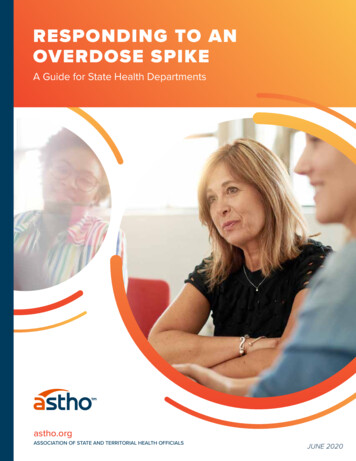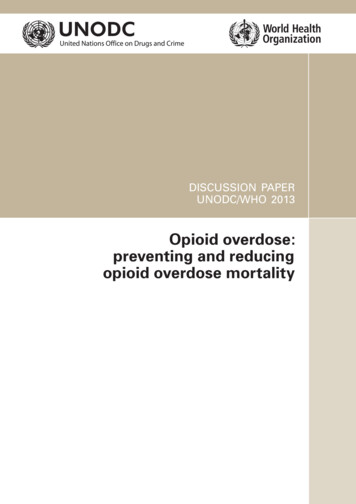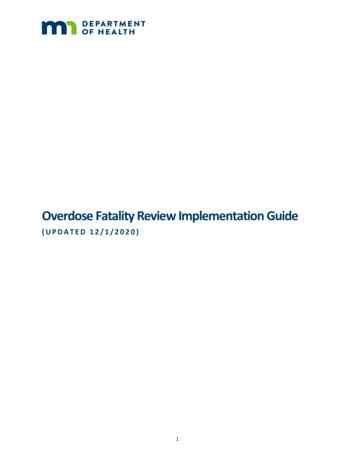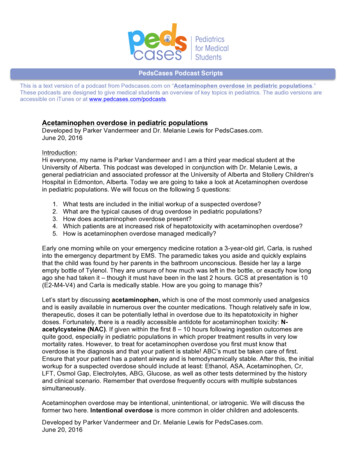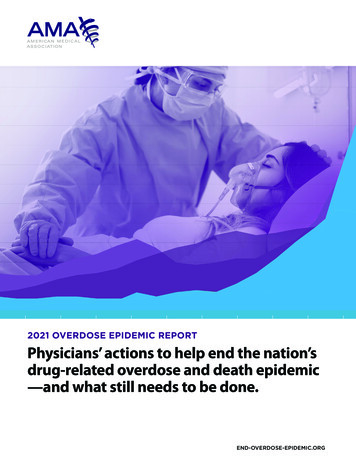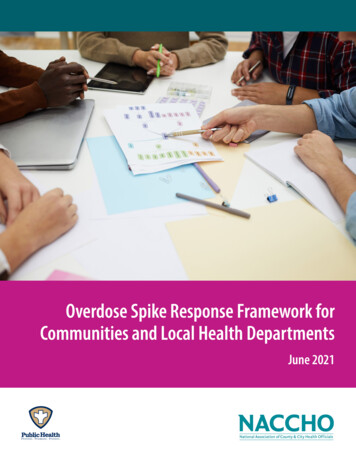
Transcription
Overdose Spike Response Framework forCommunities and Local Health DepartmentsJune 2021
OVERDOSE SPIKE RESPONSEFRAMEWORK FOR COMMUNITIESAND LOCAL HEALTH DEPARTMENTSTABLE OF CONTENTSAcknowledgements.3Introduction.4Planning for an Overdose Spike Response.51. Identify and Engage Partners.62. Convene Partners. 103. Develop a Plan. 12 Defining a Spike. 12 Verify the Data. 15 Establish a Spike Alert Protocol. 15 Identify Team Leads. 16 Develop Sub-Team-Based Plans. 164. Exercise the Plan. 20 Responding to an Overdose Spike. 20 Update Your List of Contacts. 20 Begin Scheduled Response Meetings. 20 Focus Your Response Activities. 21 Execute Coordinated Plans. 24 Deactivate the Overdose Spike Response. 245. Evaluate the Plan. 25 Continuity of Care: After the Spike. 26Summary. 27Attachments/Referenced Documents. 28Appendix A: Non-Stigmatizing Language Chart/Examples. 28Appendix B: Resources for Developing Spike Alert Messaging. 30Appendix C: Examples of Data Sources for Monitoring Overdose Spikes. 39Overdose Spike Response Framework for Communities and Local Health Departments 2
ACKNOWLEDGEMENTSThis framework was supported by funding from the U.S. Centers for DiseaseControl and Prevention (CDC). The National Association of County and CityHealth Officials (NACCHO) would like to thank the following leaders who servedon the Spike Response Framework Workgroup and who guided and informed thecontent of this document:Aliese AlterJeff BeesonErica BergstromGina BryanPatsy Rubio CanoPierre-Olivier CoteCheryl B. DesbordesSarah Summers JewelMarquis JohnsonSarah JohnsonRebecca KaufmanJulia MandevilleBarbara MarshCheryll MooreSandy O’NeillPhillip A. PerezStephanie RubelMelanie RuheCourtney SerraCasey SmithStacy StanfordLauren WhitemanJessica WolffWashington-Baltimore High Intensity Drug Trafficking Area ProgramWashington-Baltimore High Intensity Drug Trafficking Area ProgramWalworth County (WI) Department Health & Human ServicesHouston (TX) Recovery CenterHouston (TX) Health DepartmentU.S. Centers for Disease Control and PreventionGeorgia Department of Public HealthNational Association of County and City Health OfficialsWashington-Baltimore High Intensity Drug Trafficking Area ProgramPublic Health Madison & Dane County (WI)Broome County (NY) Health DepartmentNational Association of County and City Health OfficialsPublic Health – Dayton & Montgomery County (OH)Erie County (NY) Health DepartmentAnne Arundel County (MD) Health DepartmentLos Angeles County (CA) Dept Public HealthU.S. Centers for Disease Control and PreventionNational Association of County and City Health OfficialsShelby County (TN) Health DepartmentPublic Health – Dayton & Montgomery County (OH)National Association of County and City Health OfficialsFlorida Department of Health in Broward CountyU.S. Centers for Disease Control and PreventionNACCHO also acknowledges the Association of State and Territorial HealthOfficial’s (ASTHO) previous work that provides guidance to state healthdepartments in responding to overdose spikes.This publication was made possible by grant number 6 NU1ROT000015-01-02;Technical Assistance for Response to Public Health or Healthcare Crises fromthe CDC. Its contents are solely the responsibility of the authors and do notnecessarily represent the official views of the CDC.Overdose Spike Response Framework for Communities and Local Health Departments 3
INTRODUCTIONThe purpose of this resource is to help local health departments (LHDs)plan for, respond to, and evaluate public health responses to overdosespikes. LHDs play a leading role in detecting spikes and responding tothem; but they are not alone. Much of their role requires coordination withother response partners in the planning, execution, and evaluation of anoverdose spike response. As the local public health authority, LHDs are bestsuited to coordinate response efforts among first responders, healthcare,and community-based organizations to efficiently leverage available harmreduction, treatment and recovery resources. This unique role of conveningmulti-sector partners is even more critical when co-occurring crises, suchas the COVID-19 pandemic, or other natural disasters, limit organizations’capacity to prepare for and respond to an overdose spike event.Multiple factors may trigger an overdose spike in a jurisdiction, including: Changes in the illicit drug supply or "bad batches"and changes to illicit drug trafficking patterns; Limited access to behavioral health and mental healthservices, recovery support and harm reduction services; Global pandemics, dismantling homelessencampments, and other social stressors; Changes in access to prescription pain medications or treatment.Understanding the root cause of an overdose spike can take time; therefore,a swift and effective spike response typically necessitates multipleinterventions from a variety of sectors. This document has been producedto assist LHDs with guidance as they develop their context-specific responseto overdose spikes as drug trends, overdose frequency, and public healthand public safety resources will be unique to each local jurisdiction.Overdose Spike Response Framework for Communities and Local Health Departments 4
PLANNING FOR ANOVERDOSE SPIKE RESPONSEWhile it may feel impractical to prepare for another emergency in themidst of other competing challenges, prioritizing preparedness is evenmore critical during these times of increased strains on organizational andresource capacity. The more prepared a jurisdiction is for an overdose spike,the more swiftly and efficiently stakeholders can act when one occurs.Planning for an overdose spike response begins with relatively simplesteps that can have long-lasting and wide-ranging benefits. The fivemain steps of planning for an overdose spike response are:12345IDENTIFY AND ENGAGE PARTNERSCONVENE PARTNERSDEVELOP THE PLANEXERCISE THE PLANEVALUATE THE PLANOverdose Spike Response Framework for Communities and Local Health Departments 5
PLANNING FOR AN OVERDOSE SPIKE RESPONSE1 IDENTIFY AND ENGAGE PARTNERSThe goal of identifying partners before a spike occurs is to create a formal network ofindividuals and organizations that can provide enhanced harm reduction, treatment,recovery and other services to the affected jurisdiction. Doing so may requireremoving barriers and increasing access to the affected populations, so a variety oforganizational roles may be leveraged in a response. Relationships are incredibly usefulat times of crisis. Therefore, a little bit of pre-work to establish this network can savetremendous time during an actual response.Remember, a major role of the LHD in an overdose spike response is that of convener.Therefore, while some individuals in the LHD may be familiar with some individualsworking in partner organizations or agencies, planning involves bringing the relevantpartners together to engage with and learn about one another’s roles and capabilities.RESOURCESKey Partner Roles and Responsibilities GuidanceAs stated in the "Community Response Plan Template: Guidance forCoordinated Response to Rapid Increase in Drug Overdoses" from theOhio Department of Health, partner agencies and organizations are anessential component of a strong Community Response Plan. The belowsection from the Ohio response plan template outlines the recommendedroles that partners would play in the event of a spike in overdosesin a county. Please note the list is not exhaustive; rather, it outlinesrecommended partners and actions they would take.The partners and actions should be modified to best fit your county.Recruit key stakeholders from your coalition and your Overdose FatalityReview, as well as from the wider community. The Ohio response plantemplate recommends that you plan a meeting with key stakeholdersidentified to play a role in the response efforts: discuss roles andresponsibilities they feel need to be addressed during an alert or arewithin their scope of practice. Once everyone has decided which roles/responsibilities they are comfortable with, get formal or informalcommitments from agencies to fulfill those roles during an alert. Partnerbuy-in is a key component to ensuring that the plan can be effectivelyenacted in the event of a spike.Read the full Community Response Plan Template fromthe Ohio Department of verdose Spike Response Framework for Communities and Local Health Departments 6
PLANNING FOR AN OVERDOSE SPIKE RESPONSE1 IDENTIFY AND ENGAGE PARTNERS (CONT’D)Identify and engage partner organizations and community stakeholders, ensuring thatyou have representation from the following:Local health department contact (include emergency responsecoordinator, if applicable)State health department contact (include emergency responsecoordinator, if applicable)Behavioral health, treatment providers, including prescribers ofmedication for opioid use disorderHarm reduction service providers and consumersLocal hospital and emergency department contacts/physicians/liaisonsFirst responders, including EMS and fire departmentsNaloxone distributorsNaloxone administration trainersPeer recovery/support service providers with lived experienceHousing/homeless servicesLaw Enforcement to include local High Intensity Drug TraffickingArea (HIDTA) program, Overdose Response Strategy Public HealthAnalyst and Drug Intelligence Officer, all local police departments,mass transit authorities, and local college campus policeCrisis and risk communication expertsQuick response teams/Crisis response teams, if availableRisk communication/media outreach specialists and media contactsPain clinicsCommunity anti-drug coalitions and advocacy groupsSocial service providers, including child and family serviceAs you reach out to individual partners to invite them to be part of an overdose spikeresponse team, ask each partner who else should be included in response planning, andcross-check suggestions with your list so that by the end, you have a comprehensive listof key partners.HELPFUL TIP:Utilize online file sharing tools, such as Google Docs, or SharePoint sites, so thatpartners can verify and edit their own contact information and provide accurateagency/program acronyms. This way, the responsibility does not fall on a singleindividual to compile the information.Overdose Spike Response Framework for Communities and Local Health Departments 7
PLANNING FOR AN OVERDOSE SPIKE RESPONSE1 IDENTIFY AND ENGAGE PARTNERS (CONT’D)RESOURCESNational Incident Management System (NIMS)NIMS is a comprehensive, national approach to incident management thatis applicable at all jurisdictional levels and across functional disciplines. Itis intended to: Be applicable across a full spectrum of potential incidents, hazards, andimpacts, regardless of size, location or complexity. Improve coordination and cooperation between public and privateentities in a variety of incident management activities. Provide a common standard for overall incident management.The Command and Management component within NIMS is designedto enable effective and efficient incident management and coordinationby providing a flexible, standardized incident management structure.To institutionalize these activities within a formal structure, commandand management includes three fundamental elements: the IncidentCommand System (ICS), Multiagency Coordination Systems (MACS), andPublic Information. When an incident requires response from multiplelocal emergency management and response agencies, effective crossjurisdictional coordination using common processes and systems is critical.The Incident Command System (ICS) provides a flexible, yet standardizedcore mechanism for coordinated and collaborative incident management,whether for incidents where additional resources are required or areprovided from different organizations within a single jurisdiction or outsidethe jurisdiction, or for complex incidents with national ms/nimsfaqs.pdfThe Community Overdose Action Team in Montgomery County, Ohioutilizes the Incident Command System (ICS) structure for their response tothe drug overdose and addiction crisis. ICS is the standard for emergencymanagement across the United States and is used to manage local, stateand federal responses to complex emergencies. Public Health regularlyutilizes ICS to respond to disease outbreaks. Given the devastating impactsdrug overdoses were having on the community in Montgomery County,structuring the county-wide response under ICS made perfect sense. ICShas provided a coordinated management system, allowing communitypartners to work collaboratively towards addressing overdoses andaddiction in Montgomery County. For more information on PHDMC’sresponse strategies, visit their website here:https://www.mccoat.org/Overdose Spike Response Framework for Communities and Local Health Departments 8
PLANNING FOR AN OVERDOSE SPIKE RESPONSE1 IDENTIFY AND ENGAGE PARTNERS (CONT’D)Response teams that often include multi-disciplinary experts in emergency medical,mental health and substance use disorder, and trauma services are commonly usedin local jurisdictions. These teams can help reduce risk, provide appropriate andimmediate care, and divert individuals away from the criminal justice system towardappropriate support services.RESOURCESQuick Response Teams (QRTs)An integrated, first responder and community paramedicine unit comprisinglaw enforcement officers, rescue personnel, health care professionals and / orsubstance abuse counselors.A QRT is trained to serve as a first responder unit for narcotic-related medicalemergencies and, thereafter, to approach and counsel overdose victims duringtheir “recovery windows” — the 72 hours immediately following life-threateningdrug overdoses — when users are thought to be more open to accepting nity-paramedicine-quick-response-teams.htmlCrisis Response Team (CRT)A group of individuals specifically trained to provide trauma mitigation, educationand emotional first aid in the aftermath of a critical incident, either small-scale ponse-program/overview/Coordinate With Your State’s Overdose Spike Response TeamYour state health department or local harm reduction program may have itsown overdose response plan, including how the state will support local efforts.Be sure to communicate within your state, to ensure that plans are coordinatedand complementary.Overdose Spike Response Framework for Communities and Local Health Departments 9
PLANNING FOR AN OVERDOSE SPIKE RESPONSE2 CONVENE PARTNERSBefore you convene a meeting, provide the following to all participants: Proposed contact list List of key terms, definitions, and acronyms (including state and local agencyand program acronyms) Educational and informational resource links Current overdose rates for your jurisdictionYou may need to educate some partners on drug use, opioid use disorder, opioidwithdrawal symptoms, stigmatizing language, and other related topics. Be preparedto provide, and encourage the use of, resources that partners can review on their owntime. See Resources list below on page 11.The goals of an initial meeting are the following: Orient the entire group to the purpose of planning for an overdose spikeresponse Introduce each partner/stakeholder by face, name, organization, and role Gain buy-in for collaborating in the planning, response, and assessment of alocal overdose spike responseOverdose Spike Response Framework for Communities and Local Health Departments 10
PLANNING FOR AN OVERDOSE SPIKE RESPONSE2 CONVENE PARTNERS (CONT’D)RESOURCES —LIST 1Shatterproofhttps://www.shatterproof.org/Naloxone Training VideosInstructions for administration of NARCAN Nasal Spray 4mg:https://www.youtube.com/watch?v tGdUFMrCRh4Opioid Rapid Response Team (ORRP) Training for NAL.pdfWords Matter: How Language Choice Can Reduce e-Can-Reduce-Stigma.pdfNational Institute on Drug Abuse (NIDA) Opioid idsCDC Opioid ex.htmlSubstance Abuse and Mental Health Services Administration(SAMHSA) Overview of Medications for Opioid Use -treatmentCDC Evidence-Based Strategies for Preventing Opioid Overdose:What's Working in the United ed-topics/evidence-basedstrategies.htmlSaint Paul Police Department’s Co-Responder, Spike potlight-StPaul-MN.pdfOverdose Detection Mapping Application Program (ODMAP)Training Manual - February eral-info/ODMAPTraining-Manual.pdfPublic Health and Safety Teams (PHAST) /files/files/PHAST Web ToolkitPilot Version 2.0 For Dissemination.pdfOverdose Spike Response Framework for Communities and Local Health Departments 11
PLANNING FOR AN OVERDOSE SPIKE RESPONSE3 DEVELOP THE PLANIf you do not already have an overdose spike response plan, begin by reaching outto other local health departments and harm reduction programs in your network aswell as your state health department to request examples of definitions, plans, andcommunication tools that can be adapted to your specific local needs.The overdose spike response plan should provide clear instructions and goals on thefollowing:A. Defining a Spike: How will you detect a spike?B. Verify the Data: How will you verify that a spike is occurring?C. Establish Spike Alert Protocol: How will you notify response partners andmaintain effective communication throughout the response?D. Identify Team Leads: What specific response roles does each partner play inthe response?E. Develop Sub-Team Plans: What specific activities does each partner engagein during the response?A. Defining a SpikeA spike will be defined by the number of suspected overdoses in a jurisdictionwithin a certain timeframe that exceeds a certain threshold, and therefore triggersthe Overdose Spike Response. In some cases, the state health department maynotify the LHD of an overdose spike. In other cases, a spike will first be identified bylocal stakeholders. LHDs should be specific on what defines a spike (substance(s),intentional/unintentional) for their explicit jurisdiction as well. To determine whether aspike is occurring, overdose case rates (suspected or confirmed) should be monitoredregularly by the LHD. Jurisdictions may use any of the following data sources tomonitor local overdose rates: Coroner/medical examiner reporting (deaths) First responder overdose reporting of overdoses or naloxone administrations(EMS, fire, police, or ODMAP data) Emergency department/hospital dataDepending on what data source(s) you are using to monitor overdose trends, you willneed to determine a threshold at which a spike response is triggered. This could bea percentage increase from the previous month or quarter, or it could be based onseveral standard deviations above the mean.Overdose Spike Response Framework for Communities and Local Health Departments 12
PLANNING FOR AN OVERDOSE SPIKE RESPONSE3 DEVELOP THE PLAN (CONT’D)Selecting a Clinically Significant Overdose ThresholdClinical significance refers to “the practical importance of an effect” andwhether there is a noticeable change due to an intervention. In this instance,an example will be an increase in overdoses. Thus, the threshold should beclinically significant and not just statistically significant. It is important that thefelt effect is big enough due to the intervention.Data from multiple sources should be examined to determine whetherthe statistically significant increase really is beyond what is expected givenhistorical trends and contextual factors. There might be statistically significantincreases that are short in duration and that cannot be addressed practically(e.g., a small bad batch that causes an increase in overdoses during a fewdays but then abates after the bad batch is exhausted). Beyond identifying astatistically significant increase using data from a given source, there are otherfactors to consider to determine if/how, where, when, and what interventionsshould be y/clinically-significant/Data DashboardsSome jurisdictions may develop data dashboards to alert a variety ofstakeholders of overdose trends and potential spikes, or they may use ODMAP,which has a spike alert system that is triggered (by default) when cases increasetwo standard deviations above the mean in the past 24 hours for a particularcounty and state; the threshold can be adjusted as needed.Overdose Detection Mapping Application Program (ODMAP)ODMAP provides near real-time suspected overdose surveillance data acrossjurisdictions to support public safety and public health efforts to mobilize animmediate response to a sudden increase, or spike in overdose events. It linksfirst responders and relevant record management systems to a mapping toolto track overdoses to stimulate real-time response and strategic analysis acrossjurisdictions.http://www.odmap.org/Overdose Spike Response Framework for Communities and Local Health Departments 13
HELPFUL TIP:Any health department can take steps to monitor for overdose spikes. One easyway is to use conditional formatting in Microsoft Excel tables to automaticallycalculate and alert you when the number of overdoses in any time period exceedsthe previous time period’s overdoses by a certain amount (threshold).As you can see, from the example in Figure 1 below, May and July data are redbecause during those months, the number of overdoses exceeded the thresholdset, in this case at least 50% higher than the previous months. In addition, aconditional formatting formula was used to examine trends by quarter. Thenumber of overdoses in Q2 is highlighted red because it exceeds the threshold setfor comparing it to Q1.As shown in Figure 1 below, smaller incremental increases month to month canhide gradual increases. The quarter to quarter analysis in the example belowhighlights that, in the second quarter of 2020, this jurisdiction saw 3.4 times asmany overdoses as they did in the first quarter of the same year.Setting up these types of conditional formatting formulas can help your healthdepartment save time as you monitor trends month to month, quarter to quarter,and year to year.As a reminder, changes in small counts can produce high percent changevalues that might or might not be indicative of a spike and the need to mobilizeresources.FIGURE 1. Overdose monitoring using conditional formatting in Microsoft ExcelOverdose Spike Response Framework for Communities and Local Health Departments 14
B. Verify the dataNo matter what monitoring and methods are used, always verify the data validity andconsider whether possible reporting delays or errors may be causing the appearanceof a spike. This can be done by asking reporting agencies to verify the dates whenoverdoses occurred. The added step involved in validating the data is worthwhile toavoid activating a spike response unnecessarily. Crosschecking the information usingmultiple and reputable data sources is very beneficial. Refer to Appendix C for datasource options and examples.C. Establish a Spike Alert ProtocolSwift, accurate communication is a key component of any overdose spike response.Any partner can notify the LHD in the event of a suspected overdose spike. The LHDshould verify the spike before alerting the rest of the overdose response partners viaagreed upon communication channels. Your network may also choose to create anemergency phone-based, or text-based alert system to formally notify the appropriatepartners that the overdose spike response team is being mobilized.After the alert is issued, follow-up correspondence should notify the team of aresponse meeting appointment, where additional information about the spike willbe relayed. Ideally the response meeting should occur as soon as possible (within 24hours), even if limited information is known.RESOURCESExamples of spike alert public /1736/May-15-2020Drug-Overdose-Spike-AlertOverdose Spike Response Framework for Communities and Local Health Departments 15
Planning for 24/7/365 ResponseIt is important that the LHD and partners plan for and are prepared torespond outside of normal hours of operation (i.e. Monday through Friday,9am-5pm). This is a coordinated effort as most health department stafftypically do not work beyond the normal hours of business. As a teambased response, ensure that local EMS, fire fighters, police, hospitals andother direct service providers who are accustomed to 24/7 staffing modelsare on the appropriate response teams.D. Identify Team LeadsWithin the overdose spike response team, often sub-teams or smaller topic-specificgroups may form. Identify team lead(s) and roles for these smaller groups. Theseteams might include: Harm Reduction sub-team: Team that coordinates naloxone distribution(to people who use drugs, their contacts, first responders and those most likelyto encounter overdoses); harm reduction mobile unitsSupport Services sub-team: Team that coordinates post-overdose andsurvivor support services, and/or peer support services. May also coordinatefirst responder health and well-being training and support servicesTreatment sub-team: Team that coordinates treatment facility informationCommunications sub-team: Team that coordinates the communicationsto the public (alerts to local hospitals, partner organizations, local media, socialmedia) such as:* “Bad batch” alerts* General “overdose spike” alert* Harm reduction/overdose education/911 Good Samaritan PSAsHELPFUL TIP:In your contacts spreadsheet create a separate column for each type of overdoseprevention strategy used in your jurisdiction (e.g., mobile syringe servicesprograms, naloxone distribution, and Quick Response Teams). For each contactagency, indicate whether it has capabilities relevant to each strategy by markingthe appropriate cell.Overdose Spike Response Framework for Communities and Local Health Departments 16
Chart 1. Example of Opioid Intervention Team Organizational Chart,Anne Arundel County, City of Annapolis.Anne Arundel County City ofAnnapolis Opioid Intervention TeamHealthOfficerDataTeamEmergencyManagersSenior PolicyGroup ChairPublic InformationOfficerLaw EnforcementFire, EMS, 911Health & MedicalJustice SystemPolicy Department(s)Sheriff’s OfficeMaryland State PoliceNarcotics Task ForceAllied lawEnforcementAgenciesMedical DirectorEmergency MedicalServices9-1-1CommunicationsCenter(s)MIEMSS RegionalLiaisonOCME ForensicInvestigatorHealth al Clinics &FacilitiesTreatment FacilitiesPharmaciesCrisis InterventionTeamState’s Attorney’sOfficeDistrict AttorneyCorrectional ServicesDetention CentersJustice ServicesTeen CourtDrug CourtJuvenile CourtDivisionParole and ProbationJoint InformationHuman ServicesEducationHuman ResourcesSocial ServicesF
resource capacity. The more prepared a jurisdiction is for an overdose spike, the more swiftly and efficiently stakeholders can act when one occurs. Planning for an overdose spike response begins with relatively simple steps that can have long-lasting and wide-ranging benefits. The five main steps of planning for an overdose spike response are:
